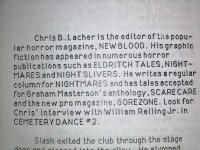Richard Chizmar founded Cemetery Dance Magazine in 1988. It’s still in production today (now managed by author/ editor Brian James Freeman) & is considered one of the best horror mags of all time, having published and even discovered many of the genre’s most famous and successful authors. This blog series is my attempt to read, review, and research every story CD has ever printed. As of Issue #70 (Sept. 2013), there are more than 500.
STORY: “Leg Man”
AUTHOR: Chris B. Lecher
CD APPEARANCE: Issue #1 (Dec. 1988: Vol. 1, Iss. 1), story 5 of 12
PLOT: A gruesome story told in 4 parts…
1) Slash is a taking a break from his band’s set in an alley. He meets a girl there. She is shirtless beneath her jacket. She seduces him easily. As he suckles her breasts, her breasts suddenly seize his tongue and slash the inside of his mouth “like a frenzied piranha”.
 |
| YIKES LOOK AT THIS
GRUESOME PIC |
2) Izzy, another band member, comes out just in time to watch Slash flounder with his shredded mouth before bleeding to death.
3) Time has passed and Izzy is still having nightmares and the band is seeing hard times. Many of his dreams feature a “girl-thing” that Izzy knows isn’t human but is responsible for Slash’s death. Then another band-mate, Axl, comes in and tries to convince him to have a good time with the two girls he brought back. Izzy declines and almost falls back to sleep when one of the girls (who he hasn’t yet even seen) whispers “Night, Izzy.”
4) After successfully falling back to sleep, Izzy wakes to hear chewing sounds and Axl moaning. He thinks it’s the sounds of sex and goes once again back to sleep. The next time when he wakes he hears what is clearly “hungry lapping sounds” and understands the girl-thing that killed Slash is now in his home and has already killed Axl. Izzy charges into the room and, after a brief fight, throws the girl-thing out the window. But she gets up from the bone-breaking two-story drop, and Izzy prepares for her return by stopping the kitchen sink, turning on the faucets, and plugging in one of his guitar amps. When she enters he tells her he’s “Not much of a tit man,” and then electrocutes her. After checking Axl’s body, Izzy’s girlfriend (who slept through the whole ordeal), comes out to see the carnage. She hugs him affectionately, but when her breasts graze Izzy’s shirt, he swears he feels them move.
REVIEW: 4 out of 5 stars.
 |
| CD BLURB ON LECHER |
As a reader I was grossed out by this one, nearly to the point of not enjoying it. Nearly. While Lacher’s abilities as an author are solid, the unbridled gore of this piece is simply not to my liking. In my experience there are three kinds of horror… Supernatural, Psychological, and Blood & Gore. Naturally we all have our favorites & naturally many stories overlap & use 2 or all 3 of these. This story is almost entirely Blood & Gore and as a fan of the overall genre, I wish Lecher had explained more about the background of the creature he invented rather than just the actions she takes or her physical… uh… abilities. Since my personal preference is low for Blood & Gore, I’d actually give this just 3 stars. But to be fair I gave it 4 because Lecher tells his story well. It’s smooth & to the point without overburdening the reader, which is a marked improvement over many of the other (earlier & yet-to-be-reviewed) stories in this early issue. I can’t go as high as 5 stars, though, because the story is nevertheless simple and Lecher’s characters (the human ones at least) are little more than stereotypes plus his sentence structure is, again, very basic.
As a writer I am reminded that a single great image can be powerful to my readers. Despite my personal distaste for it, the vision of a woman’s breasts having an open cavity and shark-like teeth is not one I am likely to forget soon. And the scene that describes her using that pseudo ‘mouth’ to pleasure her victim… let’s just say there are some things you can’t un-see. Which is exactly my point. Lecher nailed this element of the horror genre, and for that I applaud him.
To sum up, I don’t prefer Lecher’s style but I respect his basic talent. If gore & grue is your thing, you’ll love this one. If not, save yourself a few nightmares & pass.
